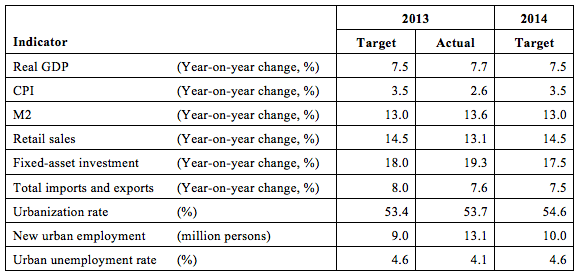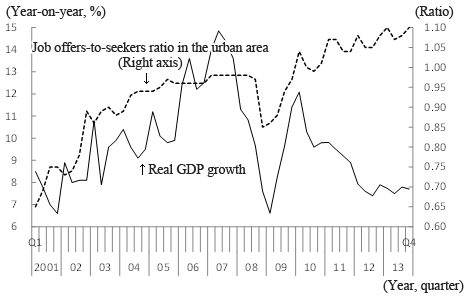The Chinese government's work report, delivered to the National People's Congress (NPC) in March 2014, has set forth a series of key economic targets for 2014 (see Table 1). Most notably, the growth target for the gross domestic product (GDP) in real terms was set at "around 7.5%," unchanged from the target for 2013. However, China's potential growth rate is believed to have fallen significantly with the continuing labor shortage as a major constraint. Coupled with little room left to implement expansionary macroeconomic policies, the government may have difficulty achieving its growth target.

Emphasis on job creation through economic growth
Premier Li Keqiang explained the background for setting the 7.5% growth target as follows:
"We set a growth rate target of around 7.5%... both to meet the need to create new urban jobs and provide opportunities for rural migrant workers who come to cities for work... ultimately... (to) ensure that urban and rural incomes increase and people's lives improve. There are many positive factors for fulfilling this year's target for economic growth, but to reach it, we must make arduous efforts."
Speaking at the news conference after the close of the NPC meeting, Premier Li said that the "around" mentioned in the GDP growth target of around 7.5% means that "there is some flexibility and we have some tolerance" for a slightly higher or lower rate of actual growth. He did not provide any specific figure for the acceptable lower limit. However, he said that the GDP growth needs to "ensure fairly full employment and realize reasonable increases in people's income," given the fact that "each year, we need to add over 10 million urban jobs and leave room for about six to seven million rural migrant workers to obtain employment in cities." (Note1) Meanwhile, in his address on the state of the economy delivered at the National Congress of the All-China Federation of Trade Unions (ACFTU) on October 21, 2013, Premier Li said that about 7.2% economic growth would be needed in order to create 10 million jobs per year. Taken together, these comments seem to suggest that the lowest acceptable economic growth rate is 7.2% (Note2).
Labor shortage as a key constraint to growth
As such, in setting the economic growth target, the Chinese government has given the maximum possible consideration to securing jobs for its people. However, China's working-age population (15 years old through 59 years old) has trended downward from 2012 onward, and the pool of surplus labor in rural areas has dried up—i.e., China has reached its Lewisian Turning Point—against the backdrop of massive labor migrations to the urban areas. As a consequence, China is now facing a significant labor shortage, which in turn is putting a constraint on economic growth.
Indeed, the job-offers-to-seekers ratio in the urban areas posted a record high of 1.1 in the first quarter of 2013 despite the GDP growth rate remaining at 7.7% (see Figure 1). Judging from the fact that the number of job offers, which represents labor demand, exceeded that of job seekers, which represents labor supply, by a significant margin of 10%, China's current potential growth rate may have fallen to around 7%, a level below the actual growth rate of 7.7%.
—Suggesting a significant decline in China's potential growth rate—

As Japan's experience with its bubble economy in the late 1980s clearly shows, an attempt to achieve a growth target that exceeds the potential growth rate by implementing expansionary macroeconomic policies may destabilize the economy. In China, clear signs of a bubble are already emerging as seen in the soaring prices of real estate, the ballooning of local government debt, and the rapid growth of shadow banking. In order to avoid an imminent crisis, the Chinese government will be forced to prioritize measures to fight the bubble over those for pump-priming the economy. With this posing a constraint to economic growth, China's GDP growth for 2014 is expected to dip to around 7%, a level lower than the government's target.


